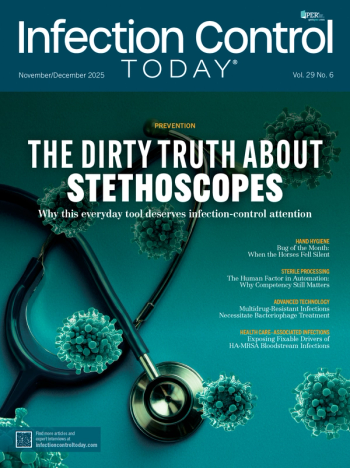
The Human Factor in Automation: Why Competency Still Matters in Infection Prevention
With hospitals across the country accelerating investments in automation, why does human competence remain vital?
Hospitals across the country are accelerating investments in automation. Automated endoscope reprocessors (AERs), surgical instrument tracking platforms, and even early artificial intelligence (AI) systems for workflow optimization are becoming standard features in sterile processing departments (SPDs) and infection prevention programs. These tools promise consistency, improved efficiency, and reduced variability. Yet one truth remains unchanged: Even the most advanced technology cannot replace the competency, judgment, and vigilance of human professionals.
In fact, evidence is increasingly showing that automation creates new challenges and cognitive demands that only a well-trained workforce can effectively navigate. Without attention to human factors—including how people interact with tools, systems, and each other—the gains promised by automation may remain out of reach.
Automation Alone Does Not Eliminate Errors
A recent study published in BMJ Quality & Safety examined assembly errors in sterile processing across a major US health system.1 Researchers found that 5% of surgical cases involved tray defects, with most of these defects originating during the assembly.1 These errors were linked not to a lack of equipment, but to production pressure, nonstandard nomenclature, and training gaps—human and system issues rather than purely technological ones.1
This finding reinforces a critical point: Scanning systems and tracking platforms cannot solve for inconsistent training or unrealistic workloads. A misnamed instrument, a rushed assembly, or a technician unfamiliar with a surgeon’s preferences can still compromise the integrity of a case. Technology reduces variability, but it does not erase the need for structured education and workload management.
Endoscope Reprocessing: The Limits of AERs
Few devices embody the tension between automation and human factors more clearly than flexible endoscopes. These instruments are notoriously difficult to clean, with intricate lumens and surfaces prone to biofilm. While AERs were designed to standardize and improve disinfection, studies have shown that they cannot compensate for poor manual cleaning practices.
In a prospective multisite study, Ofstead and colleagues found that staff awareness of reprocessing policies was high, but actual adherence was low, especially when manual steps were involved.2 Facilities with AERs exhibited somewhat better consistency, but the automation could not entirely correct for shortcuts or lapses in manual cleaning.2
More recently, van der Ploeg and colleagues reviewed 1296 reprocessing cycles and found that manual cleaning lasting 5 minutes or less significantly increased the odds of duodenoscope contamination.3 Even with automated disinfection cycles, inadequate human effort upstream created residual contamination risks.3 The takeaway is stark: A 4-minute manual clean is not only incomplete, but also a measurable risk factor.3
For infection preventionists and SPD leaders, this highlights the need for timed audits, competency assessments, and ongoing observation of manual cleaning practices. Automation must be seen as a partner to human vigilance, not a substitute for it.
System Complexity: More Interdependencies, Not Fewer
As more technologies are introduced, the work of reprocessing has not become simpler; it has become more interdependent. A 2024 ergonomics study by Segarra and colleagues mapped interactions across SPDs, operating rooms, and couriers using human factors engineering frameworks.4 They found that reliability depended less on any one tool than on cross-department coordination, clear communication, and aligned roles.4
The implication is that automation often expands the system of dependencies. For example, a tracking system may generate alerts, but unless operating room staff, SPD leaders, and couriers share a standard process for responding to them, delays and defects still occur. Infection prevention programs cannot view technology in isolation; they must be integrated into holistic workflows that are supported by staff training, clear roles, and interdisciplinary feedback loops.
AI in Infection Prevention: Promise and Peril
Beyond hardware and tracking, health care is beginning to experiment with AI tools for infection prevention and workflow optimization. These systems can flag anomalies, predict high-risk trays, or recommend process changes based on historical data. However, the human factor is even more important here.
A 2024 review identified multiple points where bias can creep into AI systems, from the data used to train models to how outputs are interpreted in practice.5 The authors warned that without human oversight and validation, AI may degrade performance for specific subgroups of patients or encourage clinicians to overtrust flawed predictions.5
Similarly, a 2024 analysis of automation bias in clinical decision support systems found that end users, especially nonspecialists, tend to rely too heavily on automated outputs.6 The authors recommended not only preventive design features (such as interface cues) but also postdeployment mitigations, including training and audit processes.6
For infection control leaders, this serves as a reminder that AI is not a plug-and-play solution. It requires transparent reporting, bias monitoring, and competency frameworks to ensure users know when to challenge and when to trust automated recommendations.
Balancing Technology With Competency Development
Taken together, these studies make a compelling case: Automation raises the floor of performance, but it does not raise the ceiling. Competency, culture, and workflow design continue to be the primary drivers of safety and efficiency.
Practical strategies for balancing automation with human factors include the following:
- Competency-based curricula: Training must be directly tied to specific manual steps (eg, timed cleaning, assembly sequencing) and reassessed regularly through observation or simulation.
- Human-in-the-loop design: AI and tracking systems should include clear opportunities for human review, second checks, and override protocols.
- System-level workflow redesign: Technology should be introduced only after assessing interdependencies across SPD, operating room, and infection prevention teams. Standardized nomenclature, tray optimization, and cross-functional huddles are critical.
- Feedback loops: Staff must see how their performance (eg, cleaning times, assembly accuracy) links to outcomes, so competency becomes a living process rather than a one-time check-off.
Automation is transforming infection prevention and sterile processing, but it is not replacing the human element. From endoscope cleaning to tray assembly to AI decision support, evidence consistently shows that technology amplifies human performance, rather than replacing it. If competencies are weak, automation can create a false sense of security. If competencies are strong, automation can reduce variability and free staff to focus on the judgment and vigilance that machines cannot replicate. The future of sterile processing is therefore not human vs machine, but human with machine…anchored in competency, oversight, and system design.
References
- Alfred M, Catchpole K, Huffer E, Fredendall L, Taaffe KM. Work systems analysis of sterile processing: assembly. BMJ Qual Saf. 2021;30:271-282. doi:10.1136/bmjqs-2019-010740
- Ofstead CL, Wetzler HP, Snyder AK, Horton RA. Endoscope reprocessing methods: a prospective study on the impact of human factors and automation. Gastroenterol Nurs. 2010;34(4):304-311. doi:10.1097/SGA.0b013e3181e9431a
- van der Ploeg K, Vos MC, Erler NS, et al. Impact of duodenoscope reprocessing factors on duodenoscope contamination: a retrospective observational study. J Hosp Infect. 2024;154:88-94. doi:10.1016/j.jhin.2024.09.018
- Segarra GC, Catchpole K, Rayo MF, et al. Revealing complex interdependencies in surgical instrument reprocessing using SEIPS 101 tools. Appl Ergon. 2024;119:104307. doi:10.1016/j.apergo.2024.104307
- Cross JL, Choma MA, Onofrey JA. Bias in medical AI: implications for clinical decision making. PLOS Digit Health. 2024;3(11):e0000651. doi:10.1371/journal.pdig.0000651
- Abdelwanis M, Alarafati HK, Tammam MM, Simsekler MC. Exploring the risks of automation bias in healthcare artificial intelligence applications: a bowtie analysis. J Saf Sci Resil. 2024;5(4):460-469. doi:
10.1016/j.jnlssr.2024.06.001
Newsletter
Stay prepared and protected with Infection Control Today's newsletter, delivering essential updates, best practices, and expert insights for infection preventionists.





